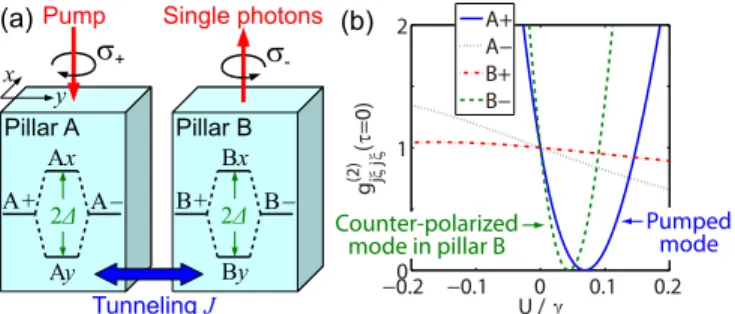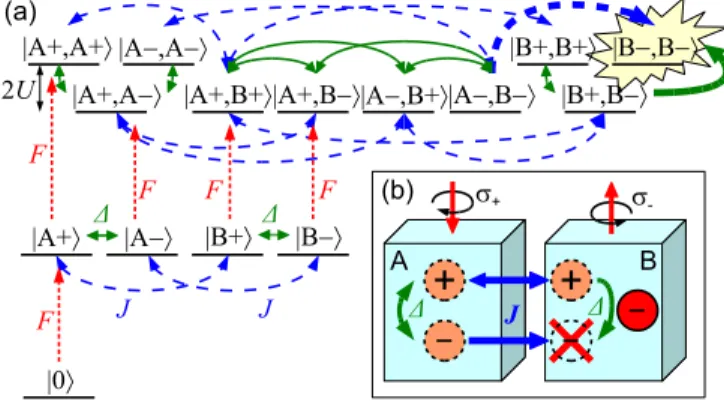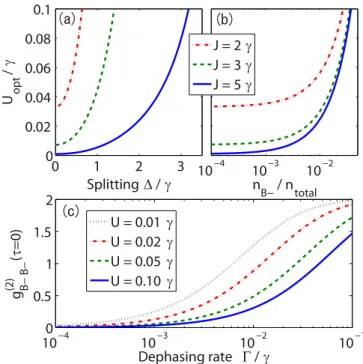HAL Id: hal-00616971
https://hal.archives-ouvertes.fr/hal-00616971
Submitted on 25 Aug 2011
HAL is a multi-disciplinary open access
archive for the deposit and dissemination of
sci-entific research documents, whether they are
pub-lished or not. The documents may come from
teaching and research institutions in France or
abroad, or from public or private research centers.
L’archive ouverte pluridisciplinaire HAL, est
destinée au dépôt et à la diffusion de documents
scientifiques de niveau recherche, publiés ou non,
émanant des établissements d’enseignement et de
recherche français ou étrangers, des laboratoires
publics ou privés.
Counter-polarized single-photon generation from the
auxiliary cavity
of a weakly nonlinear photonic molecule
Motoaki Bamba, Cristiano Ciuti
To cite this version:
Motoaki Bamba, Cristiano Ciuti. Counter-polarized single-photon generation from the auxiliary cavity
of a weakly nonlinear photonic molecule. Applied Physics Letters, American Institute of Physics,
2011, 99, pp.171111. �10.1063/1.3656250�. �hal-00616971�
Counter-polarized single-photon generation from the auxiliary cavity
of a weakly nonlinear photonic molecule
Motoaki Bamba1,a) and Cristiano Ciuti1,b)
Laboratoire Mat´eriaux et Ph´enom`enes Quantiques, Universit´e Paris Diderot-Paris 7 et CNRS, Bˆatiment Condorcet, 10 rue Alice Domon et L´eonie Duquet, 75205 Paris Cedex 13, France
(Dated: 25 August 2011)
We propose a scheme for the resonant generation of counter-polarized single photons in double asymmetric cavities with a small Kerr optical nonlinearity (as that created by a semiconductor quantum well) compared to the mode broadening. Due to the interplay between spatial intercavity tunneling and polarization coupling, by weakly exciting with circularly polarized light one of the cavities, we predict strong antibunching of counter-polarized light emission from the non-pumped auxiliary cavity. This scheme due to quantum interference is robust against surface scattering of pumping light, which can be suppressed both by spatial and polarization filters.
Single photons play an essential role in quantum in-formation technologies and their generation is a fasci-nating subject in the fields of quantum optics and con-densed matter physics. As deterministic (on-demand) sources of single photons, single semiconductor quan-tum dots embedded in optical microcavities have been investigated with impressive results in the case of non-resonant excitation.1–6 However, if one wishes to build
an array of single-photon emitters with intentional pat-tern on the same wafer, the completely random position of self-organized quantum dots is by definition a kind of limitation. In the case of non-resonant generation, the repetition rate of the single-photon source is limited by the relatively slow relaxation time of the injected carriers in the semiconductor device. For higher repetition rates and freedom in array design, the resonant photon block-ade in photonic pillars including a Kerr medium has been proposed, where the nonlinear medium is a simple semi-conductor quantum well,7 which can be patterned with
great flexibility. Unfortunately, the non-trivial difficulty of such approach is that the strength of the Kerr nonlin-earity must be much larger than the mode broadening, thus requiring in practice the use of ultrasmall photonic resonators with very high quality factors.
In a recent letter,8 it has been proved that by using
two coupled pillars (a double cavity system or photonic ‘molecule’) it is possible to get very pure single-photon emission with a nonlinearity surprisingly small with re-spect to the losses. As analytically shown in Ref. 9, the antibunching originates from the destructive quan-tum interference between excitation and tunneling paths of photons. However, a practical hurdle still remains: in the proposed scheme,8,9 single photons are emitted
from the excited cavity with the same polarization of the pump. Hence, spurious effects as pump surface scatter-ing could mask such an effect. In the present paper, we propose another scheme based on the generalization of
a)E-mail: motoaki.bamba@univ-paris-diderot.fr b)E-mail: cristiano.ciuti@univ-paris-diderot.fr (a) (b) −0.20 −0.1 0 0.1 0.2 1 2 U / γ g (2) jξ j ξ (τ =0) a a A+ A− B+ B− Pumped mode Counter-polarized mode in pillar B
FIG. 1. (a) Sketch of the system consisting of two coupled micropillars: due to the shape anisotropy, the photon eigen-modes have orthogonal linear polarizations. The mode with ξ polarization in pillar j is denoted as jξ, and the energy levels for the single photon states in each pillar are depicted. By illuminating circularly polarized light on pillar A, counter-polarized single photons are emitted from pillar B even with a small nonlinearity. (b) The equal-time second-order cor-relation functions {gjξjξ(2) (τ = 0)} are plotted as functions of nonlinearity U normalized to broadening γ. The tunneling strength is J = 5γ, the polarization splitting is ∆ = 2.5γ, and the pump frequency is tuned as δE = E − ~ωp= 0.2772γ. In
addition to the antibunching of the pumped mode A+, nearly perfect antibunching is obtained in mode B− with the rela-tively small nonlinearity U = 0.0438γ.
the photonic molecule approach by taking advantage of the polarization degree of freedom in asymmetric cavities having a frequency splitting between modes with orthog-onal linear polarizations. We show how to get counter-polarized single-photons from the non-pumped auxiliary cavity, thus providing a way to get rid of the pump spuri-ous scattering by both spatial and polarization filtering. As a realistic system, we consider two spatially separated semiconductor micropillars with asymmetric shape,10 coupled with a photonic tunneling strength J.
Each pillar has two different linearly polarized photonic modes (x and y directions), energetically split by 2∆ due to the shape anisotropy. Fig. 1(a) shows a sketch of
con-2
sidered system. The Hamiltonian is represented as ˆ H = X j={A,B} h (E + ∆)ˆa†jxˆajx+ (E − ∆)ˆa†jyaˆjy i + X ξ={x,y} J(ˆa†AξˆaBξ+ H.c.) + (F e−iωptˆa† A++ H.c.) + X j={A,B},ξ={+,−} U ˆa†jξˆa†jξˆajξˆajξ. (1)
Here, ˆajξ is the annihilation operator of a photon with
polarization ξ in pillar j. The relation between circularly and linearly polarized modes is given by the standard op-erator expression ˆaj±= (ˆajx±iˆajy)/
√
2. We consider the configuration where pillar A is pumped with σ+-circular
polarization, being ωp and F the pump frequency and
amplitude respectively. The pumping strength is mod-erate to guarantee the average number of photons in the system not exceeding unity. If the average num-ber is increased, antibunching is worsened, because the quantum interference in the present scheme is valid if three-photon subspace can be neglected, as in the pre-viously considered scenario.8,9The nonlinearity is
repre-sented by the last term in Eq. (1) conserving the total spin of two photons. The effective nonlinearity can be mediated by the presence of a quantum well excitonic resonance,11 but this effective Kerr term is quite
gen-eral for systems with a third-order nonlinearity. The cross-polarized term such as Ucrossˆa†j+ˆa
†
j−ˆaj−aˆj+ is not
considered in the present paper, because Ucross is
usu-ally much smaller than U ,12 but it could be added
with-out qualitative changes (not shown). By using the the-oretical method detailed in Ref. 7, we have numerically calculated second-order correlation functions g(2)jξj′ξ′(τ ) = hˆa†jξˆa
†
j′ξ′(τ )ˆaj′ξ′(τ )ˆajξi/hˆa†jξˆajξihˆa†j′ξ′aˆj′ξ′i at the steady state under continuous pumping and a dissipation of pho-tons with a rate γ/~ in each mode.
In Fig. 1(b), we plot equal-time correlations {gjξjξ(2) (τ =
0)} as a function of nonlinearity U normalized to γ. We consider the tunneling strength J = 5γ, polariza-tion splitting ∆ = 2.5γ, and pump detuning δE = E − ~ωp = 0.2772γ. In addition to antibunching at
the pumped mode A+ due to the previously proposed scheme8,9 strong antibunching is achieved for mode B−
with the (small) optimal nonlinearity U = 0.0438γ. In the weak pumping limit, g(2)B−B−(τ = 0) is reduced to zero. The underlying destructive quantum interference is different from the previous one in Refs. 8 and 9. By de-riving the equations of motions for the amplitudes of the possible Fock states for the zero-, one- and two-photon states (generalizing the method in Ref. 9) we have de-rived the optimal conditions of the counter-polarized an-tibunching and found the interference paths leading to the antibunching in mode B−. In Fig. 2(a), the zero-, one-zero-, and two-photon state manifolds are depicted and labeled as |0i, |jξi, and |jξ, j′ξ′i, respectively. The paths
responsible to antibunching in mode |B−, B−i are the J-assisted (spatial tunneling) path from |A−, B−i and the
FIG. 2. (a) Sketch of all the transition paths between zero-photon |0i, one-zero-photon |jξi, and two-zero-photon states |jξ, j′ξ′i.
The antibunching of mode B− is due to the destructive quan-tum interference between the two paths from |A−, B−i and |B+, B−i to |B−, B−i. (b) Pictorial representation. If there is already a “−” photon in pillar B, another “−” photon can-not exists in the same pillar because of the interference be-tween the J-assisted (spatial tunneling) path from “−” pho-ton in pillar A and the ∆-assisted (polarization coupling) path from “+” photon in pillar B. This quantum interference oc-curs for an optimal value of the nonlinearity and laser detun-ing.
∆-assisted (polarization coupling) one from |B+, B−i: destructive interference occurs for an optimal value of the nonlinearity U , which is much smaller than the in-verse of the cavity lifetime. Fig. 2(b) shows a pictorial interpretation. In presence of “−”-photon in cavity B, another photon cannot enter the same pillar due to the quantum interference. The presence of a cross-polarized nonlinear term Ucross would not change this picture (not
shown) and it does not create a new path to |B−, B−i. Furthermore, while identical pillars are supposed in the reported calculation, we have numerically checked that nearly perfect antibunching in mode B− can be obtained even under a deviation of the order of γ on eigen frequen-cies E and splitting ∆ between the two pillars, and also tunneling strength J between two polarizations, while the pumping frequency ωpshould be properly tuned.
From the equations of motions of up to the two-photon Fock states, we have calculated the optimal nonlinearity Uoptfor the perfect antibunching under the weak
pump-ing limit. Fig. 3(a) shows Uopt as a function of ∆/γ,
and Fig. 3(b) represents the ratio between the average photon number nB− = hˆa†B−ˆaB−i in mode B− and the
total number ntotal = Pj,ξhˆa†jξˆajξi for the
correspond-ing Uopt. The minimum nonlinearity that is required for
the antibunching is decreased by the increase of J, and the required nonlinearity is decreased together with the splitting ∆ (or the opposite behavior when J < ∆). How-ever, together with the decrease of Uopt, the occupation
probability of mode B− is significantly decreased as seen in Fig. 3(b). For Uopt < 0.1γ, the curve in Fig. 3(b) is
almost saturated at J = 5γ, and we can obtain a proba-bility nB−/ntotal∼ 10−2, which corresponds to a
gener-3 100−4 10−3 10−2 10−1 0.5 1 1.5 2 E Dephasing rate Γ / γ g (2) B− B− (τ =0) a a 0 1 2 3 0 0.02 0.04 0.06 0.08 0.1 C Splitting ∆ / γ U opt / γ 10−4 10−3 10−2 n B− / ntotal a a D J = 2 γ J = 3 γ J = 5 γ U = 0.01 γ U = 0.02 γ U = 0.05 γ U = 0.10 γ
FIG. 3. (a) Optimal nonlinearities Uoptare plotted as a
func-tion of ∆/γ for tunneling strengths J/γ = 2, 3, and 5. (b) Under the optimal conditions, the ratios between the average number nB− of photons in mode B− and the number ntotal
in the total system are plotted for corresponding Uopt/γ. (c)
The obtainable gB−B−(2) (τ = 0) are plotted versus the dephas-ing rate Γ normalized to γ. The tunneldephas-ing strength is J = 5γ, energy splitting ∆ and pumping frequency are chosen to give the nearly perfect antibunching for each nonlinearity U in the absence of pure dephasing.
ation rate of the order of 100 MHz for a cavity lifetime in the picosecond rage. This rate is higher than that of the quantum dots1–6 by one order of magnitude.
Finally, we have examined the robustness of the present scheme against dephasing of photons. Since quantum interferences are responsible in the present and previous schemes,8,9 pure dephasing can decrease the
quality of the antibunching. By using the standard pure dephasing model due to quadratic coupling with a reservoir,13 we consider dephasing with a rate Γ/~
af-fecting linearly polarized modes of each pillar (the re-sults shown below are not significantly modified even if the dephasing is supposed to affect the circularly polar-ized modes). Fig. 3(c) shows gB−B−(2) (τ = 0) as a func-tion of Γ/γ. The tunneling strength is J = 5γ, and the splitting ∆ is chosen to give perfect antibunching for each nonlinearity U in the absence of the dephasing. As clearly shown, the antibunching can be significantly
worsened in presence of pure dephasing for a given value of the nonlinearity. However, even if the nonlinearity is quite small, for example U = 0.05γ, antibunching is still observable if Γ = 10−2γ and becomes very strong if
Γ = 10−3γ. The curves in Fig. 3(c) does not strongly
depend on the tunneling strength J if the nonlinearity U is large enough compared to the corresponding minimum shown in Fig. 3(a). Since the optimal nonlinearity can be weak in the present scheme, one can consider cavities with relatively small photon lifetime (small quality fac-tor) in a regime where the pure dephasing time can be thus neglected, a very promising outlook.
In conclusion, we have proposed a scheme of single-photon generation due to a destructive quantum interfer-ence effect in a weakly nonlinear double cavity system, where each cavity have two linearly polarized, frequency-split modes. Due to the spatial tunneling between the two cavities and the coupling between opposite circular polarizations, we have found that strong antibunching of counter-polarized emission can be obtained at the non-pumped auxiliary pillar. This new effect is of practical implications, because it provides a direct way to suppress the pump scattering via spatial and polarization filters. This scheme can also exported to arrays of nonlinear pho-tonic molecules.
We would like to thank A. Amo, A. Bramati, J. Bloch, I. Carusotto, E. Giacobino, and A. Imamoglu for stimu-lating discussions. We acknowledge support from ANR grants SENOQI and QPOL. C. Ciuti is member of Insti-tut Universitaire de France (IUF).
1P. Michler, A. Kiraz, C. Becher, W. V. Schoenfeld, P. M. Petroff,
L. Zhang, E. Hu, and A. Imamoglu, Science 290, 2282 (2000).
2E. Moreau, I. Robert, L. Manin, V. Thierry-Mieg, J. M. G´erard,
and I. Abram, Phys. Rev. Lett. 87, 183601 (2001).
3J. Vuckovic, D. Fattal, C. Santori, G. S. Solomon, and Y.
Ya-mamoto, Appl. Phys. Lett. 82, 3596 (2003).
4D. Press, S. G¨otzinger, S. Reitzenstein, C. Hofmann, A. L¨offler,
M. Kamp, A. Forchel, and Y. Yamamoto, Phys. Rev. Lett. 98, 117402 (2007).
5A. J. Shields, Nat. Photon. 1, 215 (2007).
6J. Claudon, J. Bleuse, N. S. Malik, M. Bazin, P. Jaffrennou,
N. Gregersen, C. Sauvan, P. Lalanne, and J.-M. Gerard, Nat. Photon. 4, 174 (2010).
7A. Verger, C. Ciuti, and I. Carusotto, Phys. Rev. B 73, 193306
(2006).
8T. C. H. Liew and V. Savona, Phys. Rev. Lett. 104, 183601
(2010).
9M. Bamba, A. Imamo˘glu, I. Carusotto, and C. Ciuti, Phys. Rev.
A 83, 021802(R) (2011).
10D. Bajoni, P. Senellart, E. Wertz, I. Sagnes, A. Miard,
A. Lemaˆıtre, and J. Bloch, Phys. Rev. Lett. 100, 047401 (2008).
11C. Ciuti, V. Savona, C. Piermarocchi, A. Quattropani, and
P. Schwendimann, Phys. Rev. B 58, 7926 (1998).
12A. Amo, S. Pigeon, C. Adrados, R. Houdr´e, E. Giacobino,
C. Ciuti, and A. Bramati, Phys. Rev. B 82, 081301 (2010).
13D. F. Walls, M. J. Collet, and G. J. Milburn, Phys. Rev. D 32,


